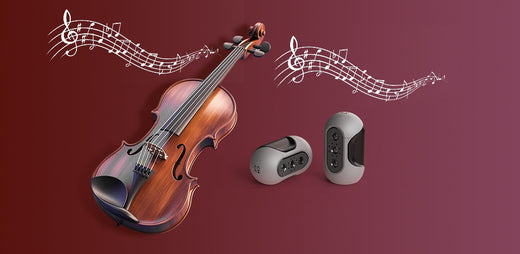Die Welt der Musikinstrumente ist so vielfältig wie die Musiker, die sie spielen. Von Saiteninstrumenten wie Geigen und Gitarren bis hin zu Blasinstrumenten wie Flöten und Trompeten – jedes Instrument hat seine eigenen Eigenschaften und Anforderungen. Mit dem Aufkommen der 3D-Scantechnologie, insbesondere der innovativen Mole 3D-Scanner hat die Individualisierung dieser Instrumente neue Höhen erreicht und ermöglicht ein maßgeschneidertes Erlebnis, das den spezifischen Bedürfnissen jedes Musikers gerecht wird. In diesem Blog untersuchen wir, wie 3D-Scanner, insbesondere der Mole 3D-Scanner, verschiedene Arten von Musikinstrumenten individuell anpassen können, die Vorteile dieser Technologie und was sie für Musiker bedeutet.
Die Vielseitigkeit des 3D-Scannens im Instrumentenbau Die 3D-Scantechnologie nutzt Laser oder strukturiertes Licht, um die genauen Abmessungen und Details physischer Objekte zu erfassen und digitale Modelle zu erstellen, die für Designzwecke bearbeitet werden können. Die Mole 3D-Scannerist mit seiner bemerkenswerten Genauigkeit von 0,05 mm und einer Auflösung von 0,1 mm ein unschätzbar wertvolles Werkzeug für die individuelle Anpassung einer breiten Palette von Musikinstrumenten.
1. Streichinstrumente
Gitarren und Bässe
Für Streicher sind das Spielgefühl und der Klang eines Instruments von größter Bedeutung. Mole 3D-Scanner ermöglicht es Gitarrenbauern, die genauen Spezifikationen des Lieblingsinstruments eines Musikers zu erfassen und es mit beispielloser Präzision nachzubauen oder zu modifizieren. Ob Anpassung des Halsprofils für mehr Komfort oder Feinabstimmung der Korpusform zur Verbesserung der Akustik – die gesammelten detaillierten Daten ermöglichen perfekt zugeschnittene Gitarren und Bässe. Beachten Sie, dass die Saiten für den Scanner schwer zu erkennen sind, da sie so dünn und fast durchsichtig sind.
Violinen und Celli
In der Welt der klassischen Musik ist die Herstellung von Geigen und Celli oft von Tradition geprägt. Mole Mit 3D-Scannern ist es möglich, historische Instrumente nachzubauen oder neue Designs zu erstellen, die die Klangqualitäten klassischer Meisterwerke beibehalten. Durch das Scannen eines vorhandenen Instruments können Hersteller dessen Merkmale analysieren und sie mit modernen Materialien nachbilden, wodurch sowohl Authentizität als auch Innovation gewährleistet werden.

2. Blasinstrumente
Blechblasinstrumente
Für Blechbläser können Passform und Gewicht eines Instruments die Leistung erheblich beeinflussen. Die Mole 3D-Scanner kann bei der Herstellung individueller Mundstücke helfen, die auf die individuellen Vorlieben des Spielers zugeschnitten sind und so Komfort und Klangqualität verbessern. Darüber hinaus sorgen die optischen Anti-Shake-Module und visuellen Tracking-Algorithmen des Scanners für ein vollständiges und genaues Modell, sodass Anpassungen am Korpusdesign von Trompeten oder Posaunen für bessere Resonanz und Spielbarkeit möglich sind.
Holzblasinstrumente
Ebenso beeindruckend sind die Anpassungsmöglichkeiten für Holzblasinstrumente wie Flöten und Klarinetten. Die MoleDie hervorragende optische Kompatibilität, auch mit schwarzen Objekten, ermöglicht eine präzise Platzierung der Tonlöcher und Anpassungen der Bohrungsmaße, was die Klangqualität erheblich beeinflussen kann. Diese individuelle Anpassung gewährleistet, dass Musiker die gewünschten Klangeigenschaften und Spieleigenschaften erzielen. Manche Musikinstrumente wirken reflektierend, aber keine Sorge, die Mole Der Scanner kann leicht reflektierende Objekte scannen. Bei stärkerer Reflexion ist ein Scanspray erforderlich. Weitere Informationen finden Sie in einem anderen Blogbeitrag. 7 Tipps zum Scannen reflektierender Objekte für detaillierte Schritte und Vorsichtsmaßnahmen.
3. Schlaginstrumente
Trommeln und Schlaginstrumente
Schlagzeuger suchen oft nach Instrumenten, die bestimmte Töne und Lautstärken erzeugen. Mit dem Mole 3D-Scannerkönnen Trommelkessel so gestaltet werden, dass eine optimale Klangresonanz erreicht wird. Das kompakte und ergonomische Design des Scanners erleichtert die Verwendung sowohl im Hand- als auch im Plattenspielermodus und erleichtert die Herstellung individueller Schlaginstrumente wie Marimbas und Xylophone, bei denen die Abmessungen der Klangstäbe angepasst werden können, um bestimmte Tonhöhen und Klangfarben zu erzeugen.

4. Vorteile der Individualisierung durch 3D-Scanning
A) Verbesserte Leistung
Maßgefertigte Instrumente verbessern die Spielbarkeit und den Komfort und ermöglichen es Musikern, Höchstleistungen zu erbringen. Durch die Anpassung von Instrumenten an individuelle Anforderungen können sich Spieler auf ihre Musik konzentrieren, ohne durch Unbehagen oder unzureichend sitzende Ausrüstung abgelenkt zu werden.
B) Einzigartige Ästhetik
3D-Scans ermöglichen nicht nur die funktionale Anpassung, sondern auch den kreativen Ausdruck. Musiker können mit Herstellern zusammenarbeiten, um Instrumente zu entwerfen, die ihren persönlichen Stil widerspiegeln und einzigartige Formen, Farben und Materialien enthalten. Diese künstlerische Freiheit führt zu einzigartigen Instrumenten, die sowohl optisch als auch klanglich hervorstechen.
C) Effiziente Produktion
Die Rapid-Prototyping-Funktionen, die durch die Mole 3D-Scanner rationalisieren den Designprozess. Sobald ein digitales Modell erstellt ist, Geomagic Wrap für 3DMakerpro Software können leicht modifiziert und getestet werden, wodurch die Zeit bis zur Herstellung eines endgültigen Instruments erheblich verkürzt wird.
5. Die Zukunft individueller Musikinstrumente
Da die 3D-Scantechnologie immer weiter fortschreitet, insbesondere mit Werkzeugen wie dem Mole 3D-Scanner, das Potenzial für individuelle Anpassungen wird nur noch zunehmen. Neue Trends wie Augmented Reality (AR) könnten es Musikern ermöglichen, ihre individuellen Designs vor der Produktion zu visualisieren, was den Prozess noch interaktiver und spannender macht. Darüber hinaus bedeutet die verbesserte Zugänglichkeit zum 3D-Druck, dass kleinere Werkstätten hochwertige, individuelle Instrumente zu wettbewerbsfähigen Preisen anbieten können.
Fazit
Der Mole 3D-Scanner revolutioniert die Herstellung individueller Musikinstrumente und bietet beispiellose Möglichkeiten zur Personalisierung und Innovation. Ob Profimusiker oder begeisterter Hobbymusiker – die Möglichkeit, Instrumente an individuelle Vorlieben anzupassen, verändert das Musikerlebnis. Mit der Weiterentwicklung der Technologie verspricht die Zukunft individueller Musikinstrumente spannender und persönlicher zu werden als je zuvor. Mole 3D-Scanner sind in dieser neuen Ära der Instrumentenanpassung führend.

















